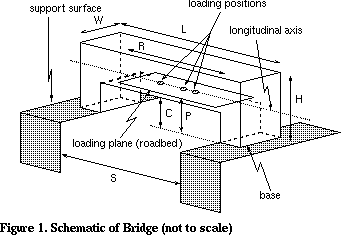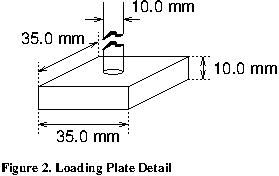
2012 International Bridge Building Contest Rules
These rules have been developed by the International Bridge Building
Committee for the Thirty Fifth International Bridge Building
Contest to be held in Las Vegas, Nevada, USA, on
Saturday, May 5, 2012. If you have a
question that is not answered by our FAQ, please direct it to Paul Matuska at
pmatuska@usbr.gov.
In order to receive official wood and participate in this contest,
a High School student must have placed first or second in a Regional
Contest and be reported (by the Regional Contest Host) to the chair of the
International Committee, Prof. John Kallend by e-mail:
kallend@iit.edu. Students may
participate in person, by proxy or by mail entry.
The object of this contest is to see who can design, construct and test
the most efficient bridge within the specifications.
Model bridges are intended to be simplified versions of real-world bridges,
which are designed to accept a load in any position and permit the load to
travel across the entire bridge.
1. Materials
-
The bridge must be constructed only from the official
3/32-inch square cross-section basswood included in the kit
and any commonly available adhesive.
-
The official basswood may be notched, cut, sanded or laminated in any
manner but must still be identifiable as the original official
basswood.
-
No other materials may be used. The bridge may not be stained,
painted or coated in any fashion with any foreign substance.
2. Construction

-
The bridge mass shall be no greater than 25.00 grams.
-
The bridge (see Figure 1) must span a gap (S) of 300. mm,
have a minimum clearance (C) of 50 mm above the support surface at
mid-span, be no longer (L) than 400 mm, be no taller (H) than
200 mm above the support surfaces, no wider (W) than 80 mm and
no narrower than 25 mm at the loading surface.
-
The bridge must be constructed to provide a horizontal support for the
loading plate and at the three loading locations described in
2d. Any portion of the structure above the loading surface must
provide clearance for the loading plate to be lowered into position
from above.
-
The load will be applied with the center of the plate at one of the
three (3) loading locations on the longitudinal axis of the bridge:
1) the center, 2) 25 mm to the right of center, and 3) 45 mm
to the left of center (see Figure 1). The three loading locations must
lie in the same horizontal plane. The loading plane must be located on
the roadbed and lie no more than a distance (P) of 100 mm above the
base of the bridge (support surface).
-
The bridge must be constructed to allow a standard Ping-Pong ball,
38.1 mm diameter to be rolled along the roadbed, from end to end
without falling off or through the bridge. To test this requirement,
the bridge will be placed at a 20 degree angle (from horizontal) and
the ball will be placed on one end of the roadbed then released. The
ball must roll freely from one end to the other. The roadbed must be
continuous, horizontal, and at least 250 mm (R) in length.
-
The bridge structure may not project below the support surfaces (see
Figure 1).
3. Loading
-
The load will be applied by means of a 35. mm square plate that
is between 10. mm in thickness. The plate will have a 10. mm
diameter loading rod threaded into its center (see Figure 2). The
plate will be horizontal; it will not pivot on the loading rod, and
during testing the sides of the plate will be placed parallel to the
longitudinal axis of the bridge.
-
The load will be applied with the loading plate centered at one of
the three positions described in section 2d.
4. Testing

-
On the day of the competition, the judges will decide which one of the
three loading locations will be used for the competition; it will be
the same for all bridges.
-
The loading plate will be located on the bridge at the specified
loading location. The load will be applied from above, as described
in section 3a above.
-
Competition loading will stop at 50. kg (approx. 110 lbs).
However, loading will continue until the bridge experiences failure.
Bridges failing above 50. kg will be considered to have held
50. kg for efficiency calculation.
-
Bridge failure is defined as the inability of the bridge to carry
additional load, or a load deflection of 25. mm under the loading
location, whichever occurs first.
-
The bridge with the highest structural efficiency, E, will be
declared the winner.
E = Load supported in grams (50,000g maximum) / Mass of bridge in grams
5. Qualification
-
All construction and material requirements will be checked prior to
testing. Bridges failing to meet these requirements will be
disqualified. If physically possible, disqualified bridges may be
tested as exhibition bridges at the discretion of the builder and the
contest directors.
-
If, during testing, a condition becomes apparent (i.e., use of
ineligible materials, inability to support the loading plate, bridge
optimized for a single loading point, etc.) which is a violation of
the rules or prevents testing as described above in Section 4, that bridge shall be disqualified. If the
disqualified bridge can accommodate loading, it may still be tested as
an exhibition bridge as stated above.
-
Decisions of the judges are final; these rules may be revised as
experience shows the need. Please check our web site,
http://bridgecontest.phys.iit.edu after March 1, 2012, to learn
whether any changes have been made.
Last update: March 12, 2012
[ Bridge Contest Home ] [ International Contest ] [ Chicago Regional Contest ]
[ Region Locator ] [ Official Documentation ] [ Other Bridge Links ]
For further information, contact: Prof. Carlo Segre -
segre@iit.edu,
Illinois Institute of Technology
© International Bridge Building Committee, 2024



